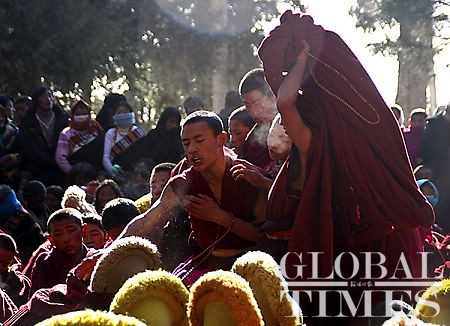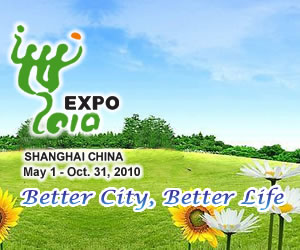Monlam Prayer Festival
Monlam Prayer Festival (祈愿大法会), the most important festival in the Tibetan Buddhist calendar, is celebrated in Gansu, Qinghai, Sichuan, Yunnan provinces and the Tibet Autonomous Region. Hundreds of people from the outlying villages and grasslands arrive at every monastery in these areas. They come by horse and motorbike, tractor and truck.
For Tibetan Buddhists this festival is to pray for peace and harmony in their lives and throughout the world. This year Monlam Prayer Festival will start on Thursday 25th of February and finish on Tuesday 2nd March.
Monlam Prayer festival is an exciting time. Old friends meet each other again, boys meet girls and plan their futures, wives and mothers shop in the village and town stores, buying food and fabrics for the coming year.
|
|
|
The child dressed up with bright, traditional hats. [Photo: Global Times] |
Everyone wears the new chupa (traditional Tibetan clothes) received for Tibetan New Year, and children will be dressed in a beautifully colored chupa, with bright, traditional hats. One or two old men will be wearing really old, very heavy chupa made of sheep skin, but with bare arms. They are so used to this costume they do not seem to feel the cold on their bare arms and legs.
During all of this day-to-day activity, special events occur at the monastery. One day will be taken up by the monks and lamas demonstrating their understanding of the spiritual texts, and arguing over the meaning of fine points within them. Later in the day, the monks will chant and hearing the throat singing is a very special experience. Throat singing provides a deeper resonance to the chanting, and matches the accompanying long horns.
|
|
|
Monks and lamas arguing over the meaning of fine points in the spiritual texts. [Photo: Global Times] |
After the day's ceremonies are finished, everyone heads for their friends'homes or the restaurants for dinner, and the night air is filled with laughter, stories and singing. The local bars open, and singers and dancers perform for the audience.
The next day will be a wonderful performance of monks dancing traditional dances (cham). These dances are spectacular, firstly because of the glorious costumes and secondly, for the agility and energy the dancers show. The costumes depict animals, devils, children and wise men and are extremely complicated and colorful. Musicians play horns, drums and gongs to accompany the dancers, but in general, the audience is too busy watching the dancers to take much notice of the music.
|
|
|
The group dance. [Photo: Global Times] |
The dancers circle the courtyard in front of the monastery, dancing and weaving in choreographed lines. Suddenly a deer or an ox will leap among them, flying high in the air, jumping up and down stairs, seemingly weightless. A little later two young monks, dressed as children will tease an older 'wise man' and he will gradually dance them into sitting beside him, so he can explain to them the special meaning of the dances.
The audience love watching the dancers, and continue to crowd into the courtyard, taking up some of the room the dancers need, so special guards will walk around pushing the people back, making sure that everyone can see. These guards are also dressed magnificently, with colored ribbons on their arms to show their role and long staves to keep people from coming too close to the dancers.
|
|
|
Monks carrying the tower to be burned. [Photo: Global Times] |
During the dancing, some of the monks build a large fire and burn special, highly scented fir tree branches. When the dancing is finished, the monks carry a large pagoda shaped wooden tower down to the stupa (lama burial tower) at the base of the monastery. Carrying the pagoda is special and a long line of monks and local Tibetans follow the tower. When the stupa is reached, another fire is built and the tower placed on it to burn. While it is burning the people in the audience wave the smoke towards themselves to bring luck and peace. Many people will walk the 'kora'–a circle around the burning tower.
The third day may be the day for seeing the beautiful butter sculptures or mandala that the patient monks have spent many weeks creating. The butter sculptures are of flowers, trees, birds, animals, and tell different stories. They are made from colored yak butter and take many hours to perfect. These sculptures can last from year to year, with the colors of the older ones fading, and smaller parts melting as time passes.
The mandala is very special in Tibetan Buddhism, and it too takes many patient hours to create. It is a circular painting made from different colored sands and generally represents the different aspects of Tibetan Buddhist belief. The painting contains many small scenes and symbols, and these are amazingly clear. At the end of Monlam Festival the beautiful mandala will be destroyed, showing the impermanence of this world, and the sand will be thrown into running water to spread the luck further.
The final day of Monlam is the day for unrolling the giant thanka. This means that we need to get up very early to join the hundreds of people climbing the mountain to the monastery so that they can get a good view of the thanka as it is unrolled.
The thanka is a very large religious painting, usually of the Buddha. Some of them are over 40 meters wide and perhaps 60-100 meters long. To be permitted to carry the thanka is a special honour, and monks and local men will vie for this honour. If you aren’t selected to carry the huge pole, then, if you are lucky, you may be able to touch it as the procession carrying it wends its way from the monastery to the display ground. This procession is accompanied by horns, drums and gongs, and many people walk along either side, hoping they can for a moment or two carry or touch it.
At the display ground the thanka is rolled onto the frames and slowly, slowly it unrolls, showing the beautifully painted Buddha. The monks chant as it unrolls and the people murmur their own prayers, fingering their prayer beads or spinning their prayer wheels.
When the ceremony is finished, and the prayers are completed, the thanka is rolled up again, and the procession returns to the monastery. Once back at the monastery, people head back into the town or village, for some last minute shopping, a little more meeting and greeting of friends they will not see for several months and a final restaurant dinner before they climb back into their conveyances to return home.
Monlam Prayer festival is over for another year.
 0
0 












Go to Forum >>0 Comments